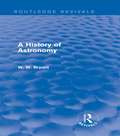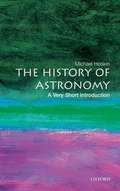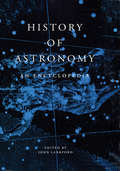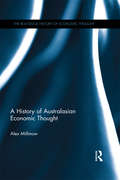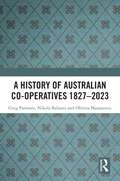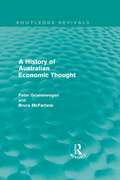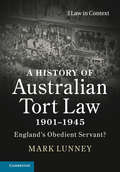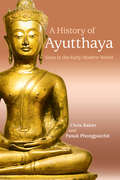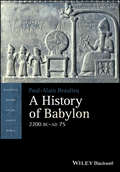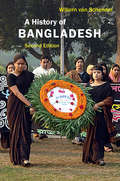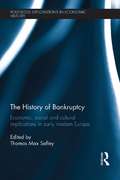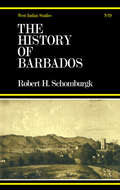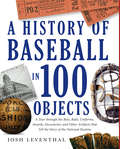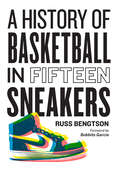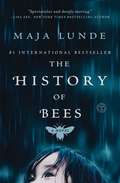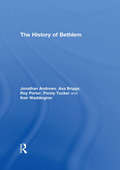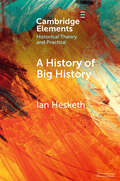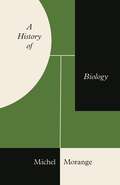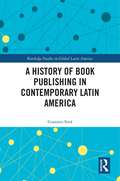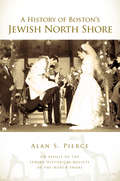- Table View
- List View
A History of Astronomy (Routledge Revivals)
by Walter W. BryantA History of Astronomy, first published in 1907, offers a comprehensive introduction to the steady development of the science since its inception in the ancient world up to the momentous progress of the nineteenth century. It includes biographical material relating to the most famous names in the study of astronomy – Copernicus, Galileo, Newton, Herschel – and their contributions, clear and accessible discussions of key discoveries, as well as detailing the incremental steps in technology with which many of the turning points in astronomy were intimately bound up.
The History of Astronomy: A Very Short Introduction
by Michael HoskinThis is a fascinating introduction to the history of Western astronomy, from prehistoric times to the origins of astrophysics in the mid-nineteenth century. Historical records are first found in Babylon and Egypt, and after two millennia the arithmetical astronomy of the Babylonians merged with the Greek geometrical approach to culminate in the Almagest of Ptolemy. This legacy was transmitted to the Latin West via Islam, and led to Copernicus's claim that the Earth is in motion. In justifying this Kepler converted astronomy into a branch of dynamics, leading to Newton's universal law of gravity. The book concludes with eighteenth- and nineteenth-century applications of Newton's law, and the first explorations of the universe of stars.
History of Astronomy: An Encyclopedia (Garland Encyclopedias in the History of Science #1)
by John LankfordThis Encyclopedia traces the history of the oldest science from the ancient world to the space age in over 300 entries by leading experts.
History Of The Attempt On Hitler’s Life (20 Jul #1944)
by Generalmajor Freiherr Rudolf Christoph von GersdorffA short but gripping account of the personal experiences of German Army Officer Freiherr Rudolf Christoph von Gersdorff, one of the conspirators against Adolf Hitler. He was deeply involved in the German opposition to the Nazi Party, and carried out an unsuccessful bomb attempt on Hitler's life in 1943.
A History of Australasian Economic Thought (The Routledge History of Economic Thought)
by Alex MillmowThis overview of Australasian economic thought presents the first analysis of the Australian economic contribution for 25 years, and is the first to offer a panoramic sweeping account of New Zealand economic thought. Those two countries, both at the start of the twentieth century and at its end, excelled at innovative economic practices and harbouring unique economic institutions. A History of Australasian Economic Thought explains how Australian and New Zealand economists exerted influence on economic thought and contributed to the economic life of their respective countries in the twentieth century. Besides surveying theorists and innovators, this book also considers some of the key expositors and builders of the academic economics profession in both countries. The book covers key economic events including the Great Depression, the Second World War, the post-war boom and the great inflation that overtook it and, lastly, the economic reform programmes that both Australia and New Zealand undertook in the 1980s. Through the interplay of economic events and economic thought, this book shows how Australasian economists influenced, to differing degrees, economic policy in their respective countries. This book is of great importance to those who are interested in and study the history of economic thought, economic theory and philosophy, and philosophy of social science, as well as Australasian economics.
A History of Australian Co-operatives 1827-2023
by Greg Patmore Nikola Balnave Olivera MarjanovicCo-operatives provide a different approach to organising business through their ideals of member ownership and democratic practice. Every co-operative member has an equal vote regardless of his or her own personal capital investment. They take a variety of different forms, including consumer co-operatives, agricultural co-operatives, worker co-operatives and financial co-operatives. Patmore, Balnave and Marjanovic provide a perspective on Australian co-operative development within a conceptual framework and international context since the 1820s by exploring the economic, political and social factors that explain their varying fortunes. Drawing upon the Visual Historical Atlas of Australian Co-operatives, a significant database of Australian co-operatives and a variety of historical sources, this book provides a detailed historical analysis of their development, from their inception in Australia to today. Australian co-operatives were heavily dependent on state sympathy for their growth and vulnerable to ideas that challenged collective organisation such as Neo-liberalism. Despite these challenges, the co-operative business model has persisted and since 2009, there has been resurgence of interest and organisation that may provide a platform for future growth. A useful resource for practitioners, students, educators, policy makers and researchers that highlights a significant alternative business model to the Investor-Owned Business and state enterprise.
A History of Australian Economic Thought (Routledge Revivals)
by Peter Groenewegen Bruce McFarlaneFirst published in 1990, this book presents an original and comprehensive overview of Australian economic thought. The authors stress, by way of introduction, the many important innovative contributions Australian economists have made to thought worldwide. As the argument develops, the work of major figures is discussed in detail in addition to the role of different journals and economic societies.
History of Australian Land Settlement
by S.H. RobertsFirst published in 1969. Routledge is an imprint of Taylor & Francis, an informa company.
A History of Australian Tort Law 1901–1945: England's Obedient Servant? (Law in Context)
by Mark LunneyLittle attention has been paid to the development of Australian private law throughout the first half of the twentieth century. Using the law of tort as an example, Mark Lunney argues that Australian contributions to common law development need to be viewed in the context of the British race patriotism that characterised the intellectual and cultural milieu of Australian legal practitioners. Using not only primary legal materials but also newspapers and other secondary sources, he traces Australian developments to what Australian lawyers viewed as British common law. The interaction between formal legal doctrine and the wider Australian contexts in which that doctrine applied provided considerable opportunities for nuanced innovation in both the legal rules themselves and in their application. This book will be of interest to both lawyers and historians keen to see how notions of Australian identity have contributed to the development of an Australian law. Places twentieth-century Australian tort law development in the context of British race patriotism. Recognises the cultural and intellectual environment in which Australian lawyers operated and how this environment influenced their perceptions of their contribution. Provides a new account of the relationship between general conceptions of national identity and the development of an Australian law; in particular, how far Australian law differed from the English common law it was assumed to follow.
A History of Ayutthaya: Siam in the Early Modern World
by Chris Baker Pasuk PhongpaichitEarly European visitors placed Ayutthaya alongside China and India as the great powers of Asia. Yet in 1767 the city was destroyed and its history has been neglected. This book is the first study of Ayutthaya from its emergence in the thirteenth century until its fall. It offers a wide-ranging view of social, political, and cultural history with focus on commerce, kingship, Buddhism, and war. By drawing on a wide range of sources including chronicles, accounts by Europeans, Chinese, Persians, and Japanese, law, literature, art, landscape, and language, the book presents early Siam as a 'commercial' society, not the peasant society usually assumed. Baker and Phongpaichit attribute the fall of the city not to internal conflict or dynastic decline but failure to manage the social and political consequences of prosperity. This book is essential reading for all those interested in the history of Southeast Asia and the early modern world.
A History of Babylon, 2200 BC - AD 75 (Blackwell History of the Ancient World)
by Paul-Alain BeaulieuProvides a new narrative history of the ancient world, from the beginnings of civilization in the ancient Near East and Egypt to the fall of Constantinople Written by an expert in the field, this book presents a narrative history of Babylon from the time of its First Dynasty (1880-1595) until the last centuries of the city’s existence during the Hellenistic and Parthian periods (ca. 331-75 AD). Unlike other texts on Ancient Near Eastern and Mesopotamian history, it offers a unique focus on Babylon and Babylonia, while still providing readers with an awareness of the interaction with other states and peoples. Organized chronologically, it places the various socio-economic and cultural developments and institutions in their historical context. The book also gives religious and intellectual developments more respectable coverage than books that have come before it. A History of Babylon, 2200 BC – AD 75 teaches readers about the most important phase in the development of Mesopotamian culture. The book offers in-depth chapter coverage on the Sumero-Addadian Background, the rise of Babylon, the decline of the first dynasty, Kassite ascendancy, the second dynasty of Isin, Arameans and Chaldeans, the Assyrian century, the imperial heyday, and Babylon under foreign rule. Focuses on Babylon and Babylonia Written by a highly regarded Assyriologist Part of the very successful Histories of the Ancient World series An excellent resource for students, instructors, and scholars A History of Babylon, 2200 BC - AD 75 is a profound text that will be ideal for upper-level undergraduate and graduate courses on Ancient Near Eastern and Mesopotamian history and scholars of the subject.
A History of Badger Baseball: The Rise and Fall of America's Pastime at the University of Wisconsin
by Steven D. SchmittFor more than a century, the University of Wisconsin fielded baseball teams. This comprehensive history combines colorful stories from the archives, interviews with former players and coaches, a wealth of historic photographs, and the statistics beloved by fans of the game. The earliest intercollegiate varsity sport at Wisconsin, the baseball team was founded in 1870, less than a decade after the start of the Civil War. It dominated its first league, made an unprecedented trip to Japan in 1909, survived Wisconsin's chilly spring weather, two world wars, and perennial budget crises, producing some of the finest players in Big Ten history—and more than a few major leaguers. Fan traditions included torchlight parades, kazoos, and the student band playing "A Hot Time in the Old Town Tonight" as early as 1901. There is painful history here, too. African Americans played on Wisconsin's first Big Ten championship team in 1902, including team captain Julian Ware, but there were none on the team between 1904 and 1960. Heartbreaking to many fans was the 1991 decision to discontinue baseball as a varsity sport at the university. Today, Wisconsin is the only member of the Big Ten conference without a men's baseball team. Appendixes provide details of team records and coaches, All Big Ten and All American selections, Badgers in the major leagues, and Badgers in the amateur free-agent draft.
A History of Balance, 1250-1375
by Joel KayeThe ideal of balance and its association with what is ordered, just, and healthful remained unchanged throughout the medieval period. The central place allotted to balance in the workings of nature and society also remained unchanged. What changed within the culture of scholasticism, between approximately 1280 and 1360, was the emergence of a greatly expanded sense of what balance is and can be. In this groundbreaking history of balance, Joel Kaye reveals that this new sense of balance and its potentialities became the basis of a new model of equilibrium, shaped and shared by the most acute and innovative thinkers of the period. Through a focus on four disciplines - scholastic economic thought, political thought, medical thought, and natural philosophy - Kaye's book reveals that this new model of equilibrium opened up striking new vistas of imaginative and speculative possibility, making possible a profound re-thinking of the world and its workings.
A History of Bangladesh
by Willem Van SchendelBangladesh is a new name for an old land whose history is little known to the wider world. A country chiefly famous in the West for media images of poverty, underdevelopment, and natural disasters, Bangladesh did not exist as an independent state until 1971. Willem van Schendel's history reveals the country's vibrant, colourful past and its diverse culture as it navigates the extraordinary twists and turns that have created modern Bangladesh. The story begins with the early geological history of the delta which has decisively shaped Bangladesh society. The narrative then moves chronologically through the era of colonial rule, the partition of Bengal, the war with Pakistan and the birth of Bangladesh as an independent state. In so doing, it reveals the forces that have made Bangladesh what it is today. This is an eloquent introduction to a fascinating country and its resilient and inventive people.
A History of Bangladesh
by Willem van SchendelBangladesh did not exist as an independent state until 1971. Willem van Schendel's state-of-the-art history navigates the extraordinary twists and turns that created modern Bangladesh through ecological disaster, colonialism, partition, a war of independence and cultural renewal. In this revised and updated edition, Van Schendel offers a fascinating and highly readable account of life in Bangladesh over the last two millennia. Based on the latest academic research and covering the numerous historical developments of the 2010s, he provides an eloquent introduction to a fascinating country and its resilient and inventive people. A perfect survey for travellers, expats, students and scholars alike.
The History of Bankruptcy: Economic, Social and Cultural Implications in Early Modern Europe (Routledge Explorations in Economic History)
by Thomas Max SafleyThis volume takes up bankruptcy in early modern Europe, when its frequency made it not only an economic problem but a personal tragedy and a social evil. Using legal, business and personal records, the essays in this volume examine the impact of failure on business organizations and practices, capital formation and circulation, economic institutions and ethics, and human networks and relations in the so-called "transition" to modern society, from the early-sixteenth to the early-nineteenth century. One group of essays concentrates on the German-speaking world and shows a common concern for the microeconomics of bankruptcy, that is, for such issues as the structure of the firm, the nature of its capital, and the practices of its partners, especially their assessment of risk. Another group of essays shifts the focus from Central to Western and Northern Europe and away from the microeconomics of the early modern firm to an institutional consideration of bankruptcy. The final group of essays turns to Southern Europe, especially the Mediterranean basin, to assess bankruptcy not as an unfortunate result of crisis, but as an intentional response to crisis. All of the contributions are the result of original research; many of the scholars publish in English for the first time. All of the chapters are founded on close archival research, offering insights not only into business organization and practice but also into social and cultural aspects of economic life from the late sixteenth to the early nineteenth century.
History of Baseball in 100 Objects
by Josh LeventhalThe only book of its kind to tell the history of baseball, from its inception to the present day, through 100 key objects that represent the major milestones, evolutionary events, and larger-than-life personalities that make up the game A History of Baseball in 100 Objects is a visual and historical record of the game as told through essential documents, letters, photographs, equipment, memorabilia, food and drink, merchandise and media items, and relics of popular culture, each of which represents the history and evolution of the game. Among these objects are the original ordinance banning baseball in Pittsfield, Massachusetts, in 1791 (the earliest known reference to the game in America); the "By-laws and Rules of the Knickerbocker Base Ball Club," 1845 (the first codified rules of the game); Fred Thayer's catcher's mask from the 1870s (the first use of this equipment in the game); a scorecard from the 1903 World Series (the first World Series); Grantland Rice's typewriter (the role of sportswriters in making baseball the national pastime); Babe Ruth's bat, circa 1927 (the emergence of the long ball); Pittsburgh Crawford's team bus, 1935 (the Negro Leagues); Jackie Robinson's Montreal Royals uniform, 1946 (the breaking of the color barrier); a ticket stub from the 1951 Giants-Dodgers playoff game and Bobby Thomson's "Shot Heard 'Round The World" (one of baseball's iconic moments); Sandy Koufax's Cy Young Award, 1963 (the era of dominant pitchers); a "Reggie!" candy bar, 1978 (the modern player as media star); Rickey Henderson's shoes, 1982 (baseball's all-time-greatest base stealer); the original architect's drawing for Oriole Park at Camden Yards (the ballpark renaissance of the 1990s); and Barry Bond's record-breaking bat (the age of Performance Enhancing Drugs). A full-page photograph of the object is accompanied by lively text that describes the historical significance of the object and its connection to baseball's history, as well as additional stories and information about that particular period in the history of the game.
A History of Basketball in Fifteen Sneakers
by Russ BengtsonA celebration of the iconic shoes and superstars who have defined the sport for decades, A History of Basketball in Fifteen Sneakers tells the story of hoops as only shoes can. The ultimate book for both hoops fans and sneaker obsessives, A History of Basketball in Fifteen Sneakers is an exciting and fascinating look at the sport written with authority and experience by former Complex and SLAM magazine editor Russ Bengtson. From primeval Converse Chuck Taylor All Stars to baroque Reebok Pumps and myth-making Air Jordans to super-high-tech Nike Adapt BBs, each chapter breaks down how a specific sneaker defined an era of basketball, transformed the culture, or changed the game. With full-color sneaker photographs and detailed illustrations throughout, the book is a kaleidoscopic celebration of the players, styles, and iconic moments that have shaped hoops both on and off the court. Topics include: Walt Frazier's PUMA Clydes and the New York City street game; Michael Jordan's first signature Air Jordan and the birth of the modern global basketball superstar; Nike Air Swoopes and the evolution of the women&’s game; sneaker tech and the rise of retro; and much more.
The History of Bees: A Novel
by Maja Lunde&“Imagine The Leftovers, but with honey&” (Elle), and in the spirit of Station Eleven and Never Let Me Go, this &“spectacular and deeply moving&” (Lisa See, New York Times bestselling author) novel follows three generations of beekeepers from the past, present, and future, weaving a spellbinding story of their relationship to the bees—and to their children and one another—against the backdrop of an urgent, global crisis.England, 1852. William is a biologist and seed merchant, who sets out to build a new type of beehive—one that will give both him and his children honor and fame. United States, 2007. George is a beekeeper fighting an uphill battle against modern farming, but hopes that his son can be their salvation. China, 2098. Tao hand paints pollen onto the fruit trees now that the bees have long since disappeared. When Tao&’s young son is taken away by the authorities after a tragic accident, she sets out on a grueling journey to find out what happened to him. Haunting, illuminating, and deftly written, The History of Bees joins &“the past, the present, and a terrifying future in a riveting story as complex as a honeycomb&” (New York Times bestselling author Bryn Greenwood) that is just as much about the powerful bond between children and parents as it is about our very relationship to nature and humanity.
The History of Bethlem
by Jonathan Andrews Asa Briggs Roy Porter Penny Tucker Keir WaddingtonBethlem Hospital, popularly known as "Bedlam", is a unique institution. Now seven hundred and fifty years old, it has been continuously involved in the care of the mentally ill in London since at least the 1400s. As such it has a strong claim to be the oldest foundation in Europe with an unbroken history of sheltering and treating the mentally disturbed. During this time, Bethlem has transcended locality to become not only a national and international institution, but in many ways, a cultural and literary myth.The History of Bethlem is a scholarly history of this key establishment by distinguished authors, including Asa Briggs and Roy Porter. Based upon extensive research of the hospital's archives, the book looks at Bethlem's role within the caring institutions of London and Britain, and provides a long overdue re-evaluation of its place in the history of psychiatry.
A History of Big History (Elements in Historical Theory and Practice)
by Ian HeskethBig History is a seemingly novel approach that seeks to situate human history within a grand cosmic story of life. It claims to do so by uniting the historical sciences in order to construct a linear and accurate timeline of 'threshold moments' beginning with the Big Bang and ending with the present and future development of humanity itself. As well as examining the theory and practice of Big History, this Element considers Big History alongside previous largescale attempts to unite human and natural history, and includes comparative discussions of the practices of chronology, universal history, and the evolutionary epic.
A History of Biology: A History Of The Molecular Revolution
by Michel MorangeA comprehensive history of the biological sciences from antiquity to the modern eraThis book presents a global history of the biological sciences from ancient times to today, providing needed perspective on the development of biological thought while shedding light on the field's upheavals and key breakthroughs through the ages. Michel Morange brings to life the dynamic interplay of science, society, and biology’s many subdisciplines, enabling readers to better appreciate the interdisciplinary exchanges that have shaped the field over the centuries.Each chapter of this incisive book focuses on a specific period in the history of biology, describing the major transformations that occurred, the enduring scientific concerns behind these changes, and the implications of yesterday's science for today's. Morange covers everything from the first cell theory to the origins of the concept of ecosystems, and offers perspectives on areas that are often neglected by historians of biology, such as ecology, ethology, and plant biology. Along the way, he highlights the contributions of technology, the important role of hypothesis and experimentation, and the cultural contexts in which some of the most breathtaking discoveries in biology were made.Unrivaled in scope and written by a world-renowned historian of science, A History of Biology is an ideal introduction for students and experts alike, and essential reading for anyone seeking to understand the present state of biological knowledge.
A History of Book Publishing in Contemporary Latin America (Routledge Studies in Global Latin America)
by Gustavo SoráThis book presents a cultural history of Latin America as seen through a symbolic good and a practice – the book, and the act of publication – two elements that have had an irrefutable power in shaping the modern world. The volume combines multiple theoretical approaches and empirical landscapes with the aim to comprehend how Latin American publishers became the protagonists of a symbolic unification of their continent from the 1930s through the 1970s. The Latin American focus responds to a central point in its history: the effective interdependence of the national cultures of the continent. Americanism, until the 1950s, or Latin Americanism, from the onset of the Cold War, were moral frameworks that guided publishers’ thinking and actions and had concrete effects on the process of regional integration. The illustration of how Latin American publishing markets were articulated opens up broader and comparative questions regarding the ways in which the ideas embodied in books also sought to unify other cultural areas. The intersection of cultural, political and economic themes, as well as the style of writing, makes this book an interest to a wide reading public with historical and sociological sensitivity and global cultural curiosity.
A History of Boston's Jewish North Shore (American Heritage)
by Alan S. Pierce Jewish Historical Society of the North ShoreForced to flee the brutal pogroms of Europe, Jewish immigrants sought refuge in the beauty of Boston's North Shore. Drawing on their artisan skills, many found work in the tanneries of Peabody and the shoe factories of Lynn, while other enterprising Jews established their own businesses in Salem and Beverly- from butcher shops and groceries to newspapers. Alongside fellow members of the Jewish Historical Society of the North Shore, Alan Pierce has carefully assembled a collection of personal histories from generations of Jewish families. Celebrating the rich flavors of Jewish culture, these accounts capture familiar faces, such as renowned athlete Herb Brenner, and recognizable landmarks like the Kernwood Country Club and the Dolphin Yacht Club, innovative establishments open to all regardless of race or religion. With entrepreneurial spirit, a little determination and plenty of faith, the North Shore's storied Jewish communities have etched enduring marks on its streets and in its synagogues.
